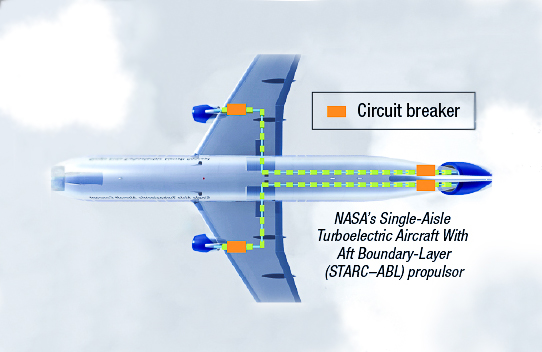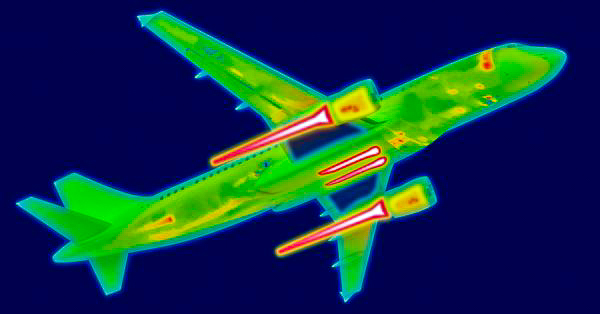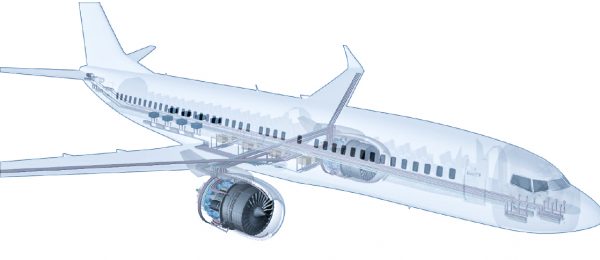Circuit Breakers
Electrifying aircraft safely and reliably requires advanced systems that are capable of managing significant amounts of electrical power and heat during flight.
When operating at high altitudes with increased voltages, electric aircraft powertrains must have safety systems that are able to quickly respond in the event of an electrical failure, as well as transfer heat efficiently throughout the vehicle in order to maximize performance and reduce fuel consumption.
Managing electrical power
Advanced Electrified Aircraft Propulsion (EAP) technologies will improve safety of aircraft electrical systems by mitigating the potential dangers of high-voltage electricity, such as electrical arching caused when currents flow through the air between conductors.
EAP research focuses on developing fault management systems with advanced circuit breakers that will protect aircraft from safety hazards by stopping the flow of electricity in an area where there is an electrical issue.

With most electric aircraft running on high voltage DC power , circuit-breaking devices designed must be lightweight, quick responding, and strong enough to manage megawatts (MW) of electricity. EAP research is advancing new circuit-breaking technology for electrified aircraft with DC solid-state circuit breakers equipped with high voltage semiconductors.
Distributed across the aircraft, solid-state circuit breakers have a significantly quicker response time and are able to interrupt power flow in a few microseconds compared to traditional mechanical circuit breakers.
Circuit breaker technology
Under the Advanced Air Transport Technology (AATT) project, NASA is developing MW-scale circuit breakers in order to achieve effective fault management. To manage MW-class power levels with 99.5% efficiency, these advanced circuit-breaking devices will operate at a targeted voltage of 1 kilowatt (kW), a current of 1000 ampere (A), and a specific power – or power-to-weight ratio of 100 kW/kg.
The circuit breakers will also have a 100 ms response time which will play a key role in controlling the flow of dangerous energy. Since electrified aircraft will operate at altitudes of approximately 35,000 ft where atmospheric pressure is low, there is an increased risk of electrical arcing. These circuit breakers are designed to operate in this reduced atmosphere environment and protect against potential hazards.
Targets for circuit breaker technology development
Metric |
Minimum |
Expected |
Stretch |
Specific Power (kW/kg) |
50 | 100 | 200 |
Voltage (kV) |
.8 | 1 | >2 |
Current (A) |
800 | 1000 | >1000 |
Response (us) |
250 | 100 | 10 |
Efficiency (%) |
99.3 | 99.5 | 99.97 |
Altitude (ft) |
25,000 | 35,000 | 51,000 |
Controlling excess heat
Electric aircraft safety systems also have the challenge of managing large amounts of heat that must be transferred efficiently throughout the vehicle during flight. Low-grade waste heat released from solid-state circuit breakers, inverters, converters, and other electric aircraft components is often low in temperature and difficult to use and transfer throughout the vehicle, therefore reducing fuel efficiency and performance.
New thermal energy conversion technologies use acoustic waves to transform low-grade waste heat to higher temperatures that can be used more efficiently throughout the aircraft.
Meeting future electrified aircraft demands
Managing megawatts of power and increased low-grade waste heat onboard, advanced circuit-breaking technology and improved thermal management systems are crucial in protecting personnel, electronics, and airframe structure.
EAP research in fault and thermal management systems will help address key challenges in electrifying flight and demonstrate innovative solutions to keeping aircraft safe and improving fuel efficiency for more sustainable air travel.
Related Publications
| Title | Authors | Date |
|---|---|---|
| "Electric Aircraft Thermal Management Using a Two-Phase Heat Transport System with Solid-State Thermal Switching Capability" | Diebold et al. | 08 July, 2021 |
| "Electric Aircraft Cooling with Bio-Inspired Exergy Management" | Dyson | 24 July, 2020 |
| "Solid-State Exergy Optimized Electric Aircraft Thermal and Fault Management" | Dyson et al. | 24 July, 2020 |
| "A Generalized Power System Architecture Sizing and Analysis Framework" | Sadey et al. | 17 September, 2018 |
| "Architecture, Voltage, and Componenets for a Turboelectric Distributed Propulsion Electric Grid (AVC-TeDP)" | Gemin et al. | 31 July, 2015 |


